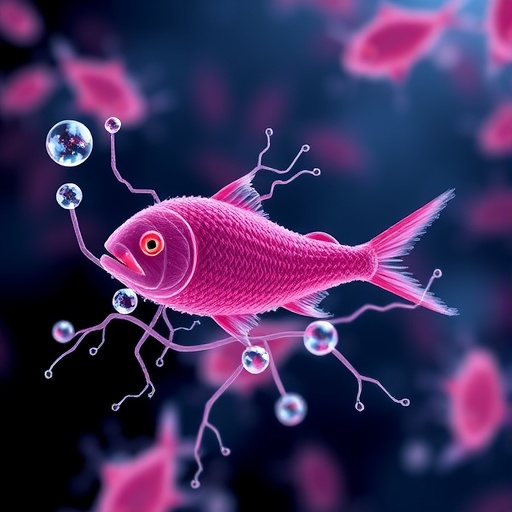In a groundbreaking study emerging from the Massachusetts Institute of Technology, researchers have uncovered a crucial mechanism by which the human body’s mucus layer combats the dangerous pathogen Salmonella enterica. The research unveils how mucins—complex glycoproteins pervasive within mucus that lines the digestive tract—can effectively neutralize the bacterium’s ability to invade host cells. This discovery presents a promising frontier in designing novel preventative strategies against Salmonella-induced diarrhea, a pervasive global health challenge.
Mucus has long been recognized merely as a physical barrier protecting mucosal surfaces, yet this research underscores mucus’s biochemical arsenal against pathogenic invaders. Central to this defense are mucins, specifically the bottlebrush-shaped polymers composed of a peptide backbone densely decorated with complex sugar structures known as glycans. The study reveals that mucins are not passive shields but active modulators that influence bacterial gene expression critical for infection.
Focusing on MUC2, a prominent mucin in the intestinal tract, the researchers demonstrated its ability to suppress the expression of Salmonella’s Type 3 Secretion System (T3SS). This system constitutes a sophisticated molecular syringe that the pathogen uses to inject virulence proteins into host cells, facilitating infection and colonization. The inhibition of T3SS effectively disarms the bacterium’s invasive machinery, preventing host cell penetration and subsequent disease manifestation.
The key to MUC2’s suppressive function lies in its interaction with HilD, a master regulatory protein within Salmonella that orchestrates the activation of T3SS genes located on the Salmonella Pathogenicity Island 1 (SPI-1). When exposed to MUC2, HilD’s regulatory capacity is impeded, thus halting the production of these virulence factors. This molecular switch-off mechanism illustrates an elegant facet of innate immunity residing within mucosal secretions.
In an innovative combination of experimental microbiology and computational modeling, the team further elucidated how specific monosaccharide components of mucin glycans, such as N-acetylglucosamine (GlcNAc) and N-acetylgalactosamine (GalNAc), interact with HilD at a defined binding site. However, these sugars alone are insufficient to repress HilD’s activity; the glycans’ tethering to the peptide backbone of the mucins is essential, highlighting the structural complexity required for effective pathogen modulation.
The scope of this mucin-mediated inhibition extends beyond the intestines. Another mucin, MUC5AC—primarily found lining the stomach—exhibits a similar capacity to inhibit HilD, suggesting a conserved defense strategy across different sections of the gastrointestinal tract. Furthermore, the effect is not limited to Salmonella but also impacts other foodborne pathogens that utilize analogous gene regulation systems, potentially broadening the protective implications of mucins.
Beyond uncovering nature’s defense strategy, the MIT researchers envision harnessing this mechanism to engineer synthetic mucins. These biomimetic polymers could augment the body’s own defenses, offering an innovative line of defense against gastrointestinal infections. Synthetic mucins might be administered in conjunction with oral rehydration salts to enhance their therapeutic efficacy or formulated into prophylactic chewable tablets to preempt infection in high-risk populations, such as travelers to endemic regions.
This synthetic approach echoes nature’s evolutionary design of mucus as part of the innate immune system, aiming not just to heal but to prevent infection proactively. By bolstering mucus barriers in vulnerable regions of the gastrointestinal tract, where natural mucus layers may be thin or absent, it may be possible to curtail the initial colonization and invasion steps of Salmonella and other bacterial pathogens.
Such intervention strategies hold the potential to substantially reduce the global burden of diarrheal disease, which is a leading cause of morbidity and mortality worldwide, particularly in developing countries. This innovative biomedical avenue could alleviate billions in healthcare costs and improve productivity by preventing illness through an accessible, low-cost prophylactic formulation.
The implications extend well into biodefense and public health domains, where rapid deployment of synthetic mucin-based products could protect soldiers, emergency workers, and populations exposed to contaminated environments. This breakthrough exemplifies how fundamental biological insights can translate into tangible health innovations.
The research, led by Professor Katharina Ribbeck and her team at MIT, involved lead authors Kelsey Wheeler and Michaela Gold, and was recently published in the journal Cell Reports. The study was supported by prominent institutions including the U.S. Army Research Office, the U.S. National Science Foundation, and the German Research Foundation, underlining the significance and collaborative nature of this work.
In summary, this research fundamentally advances our understanding of mucosal immunity by illuminating how mucus-derived glycans serve as molecular signals that incapacitate Salmonella infection machinery. It opens new horizons for preventive medicine through the bioengineering of mucin mimics—a strategy grounded in harnessing the body’s own evolutionary defense.
Subject of Research: Interaction of mucus-derived mucins with Salmonella Typhimurium to inhibit bacterial invasion through repression of SPI-1 gene expression.
Article Title: Mucus-derived glycans are inhibitory signals for Salmonella Typhimurium SPI-1-mediated invasion
News Publication Date: 23-Sep-2025
Web References: https://www.cell.com/cell-reports/fulltext/S2211-1247(25)01075-7
References: DOI: 10.1016/j.celrep.2025.116304
Image Credits: MIT
Keywords: Bioengineering, Mucus, Organismal biology, Life sciences, Diseases and disorders, Diarrhea, Symptomatology
Tags: biochemical properties of mucusglycan structures in mucinsglycoproteins in mucushuman mucus defense mechanismsintestinal mucin MUC2microbiome and human healthmucins and pathogen interactionmucosal immunity researchnovel strategies against diarrheapathogenic bacterial gene expression modulationSalmonella infection preventionType 3 Secretion System inhibition





